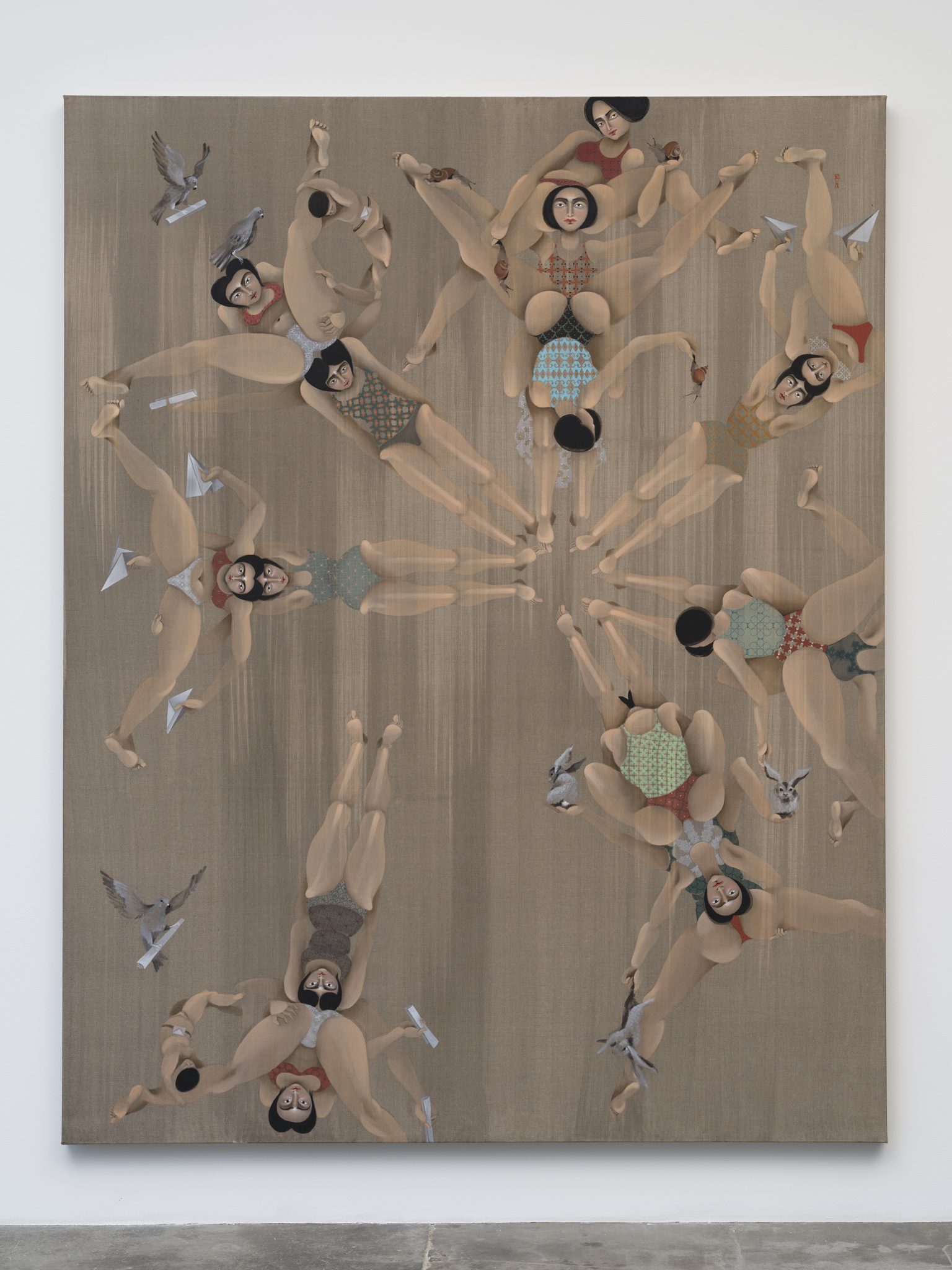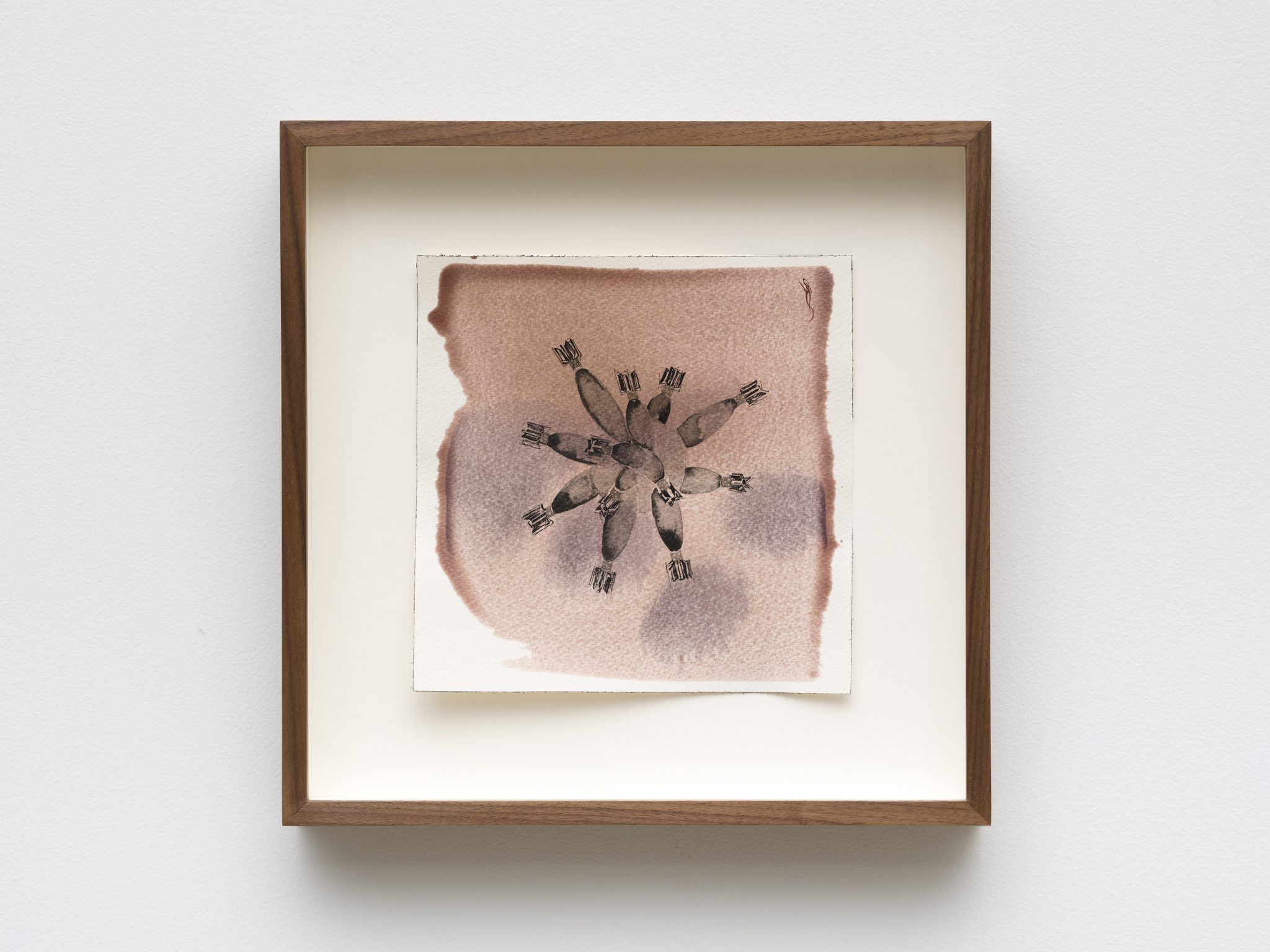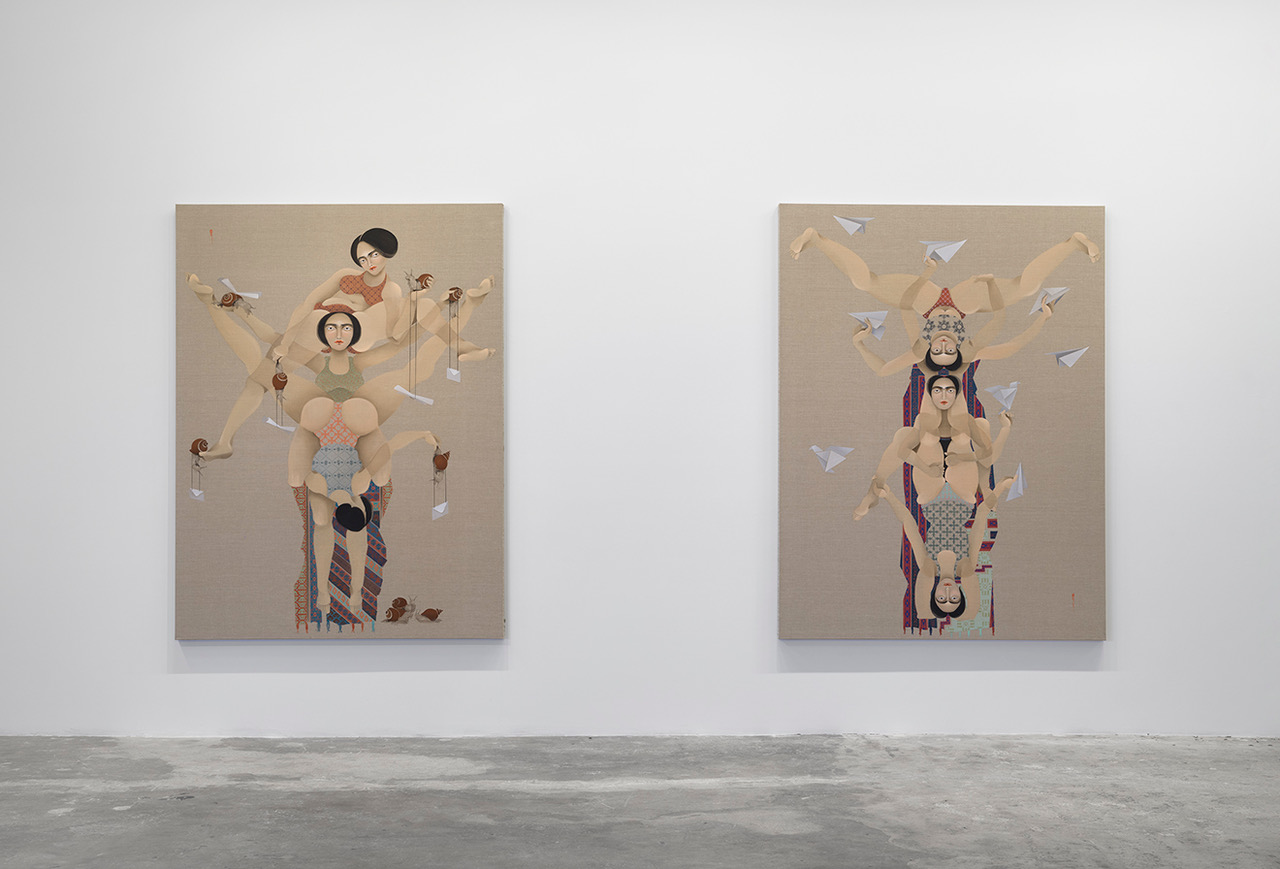

Caring for myself is not self-indulgence. It is self-preservation, and that is an act of political warfare.
-Audre Lord
About
Vielmetter Los Angeles is thrilled to announce The touch of Otherness, Hayv Kahraman’s second solo exhibition at the gallery.
Kahraman’s new paintings reflect her recent interrogation of the intersecting vocabularies of war and of immunology and epidemiology—Doctors envisioned as generals helping the patient fight the effects of external invaders, invisible terrorists, who multiply inside the body, weakening it and making it vulnerable to further contamination. In our current reality, it is impossible to ignore the parallels between the language used to describe viruses and cancers and the language used to describe migrant people. The language of war is nearly as destructive as war itself – it breaks social ties, undermines the possibility of existing in community, in solidarity, with those who are different, and renders longstanding damage to the potential of peaceful, equitable coexistence in the future. With a poetic visual language that oscillates between confrontation, humor, and tenderness, Kahraman’s recent work demands that we consider the long-term effects of militaristic metaphors in the discourse of health.
Video credit: Matthew Lax
“Bunnies,” 2021
Oil on linen
77" x 60" [HxW] (195.58 x 152.4 cm)
Inventory #KAR182
Courtesy of the artist and Vielmetter Los Angeles
Photo credit: Jeff Mclane

“Bunnies,” 2021
Oil on linen
77" x 60" [HxW] (195.58 x 152.4 cm)
Inventory #KAR182
Courtesy of the artist and Vielmetter Los Angeles
Photo credit: Jeff Mclane
For Kahraman, an Iraqi who fled her home country as a young girl during the first gulf war, living first in Sweden and later in the United States, the violence of this medical language is immediately felt and filtered through a migrant consciousness, a history of being forced to perceive herself as “other.” Her refusal to accept this negative identity, enforced from outside, found an unlikely ally figure in the language of medicine – the antibody. Ironically, it is contact, touch, intermingling that is essential to both our physical health and the health of our social ties. Antibodies are our essential immune response, proteins that are only created in response to contact from infectious cells and mediate between the touch of the other and our body. Formed through an embodied knowledge, generated through contact and collaboration; a poetic consideration of antibodies suggests a way of thinking about caring for our bodies, our health, our communities in a way that embraces permeability, inclusion, and contact.
“Pigeons,” 2021
Oil on linen
85" x 52" [HxW] (215.9 x 132.08 cm)
Inventory #KAR184
Courtesy of the artist and Vielmetter Los Angeles
Photo credit: Jeff Mclane

“Pigeons,” 2021
Oil on linen
85" x 52" [HxW] (215.9 x 132.08 cm)
Inventory #KAR184
Courtesy of the artist and Vielmetter Los Angeles
Photo credit: Jeff Mclane
“Paper planes,” 2021
Oil on linen
80" x 60" [HxW] (203.2 x 152.4 cm)
Inventory #KAR183
Courtesy of the artist and Vielmetter Los Angeles
Photo credit: Jeff Mclane

“Paper planes,” 2021
Oil on linen
80" x 60" [HxW] (203.2 x 152.4 cm)
Inventory #KAR183
Courtesy of the artist and Vielmetter Los Angeles
Photo credit: Jeff Mclane
In a statement about her most recent work, Kahraman says:
I’ve always felt “dirtier” than my Swedish schoolmates, both in image (as in the way I look) and in experience (as in the way I feel.) Foreign, dirty, filthy and impure. Contaminated. Never belonging to the tight knit group of those who are “immunized.” Instead, I’m a migrant Other who could threaten the imaginary of a pristine border wall around these purified, immunized bodies. Like a virus, my pathology renders me non-human in their eyes.
I have been examining different ways in which I can question political notions of individuality that are embedded in the rhetoric of immunology, especially concepts of self and non-self. In the language of immunology, the self/non-self relationship is rigid and absolute. There are clear delineations of where the self ends and where the non-self or the Other begins.
“Snails,” 2021
Oil on linen
80" x 60" [HxW] (203.2 x 152.4 cm)
Inventory #KAR185
Courtesy of the artist and Vielmetter Los Angeles
Photo credit: Jeff Mclane

“Snails,” 2021
Oil on linen
80" x 60" [HxW] (203.2 x 152.4 cm)
Inventory #KAR185
Courtesy of the artist and Vielmetter Los Angeles
Photo credit: Jeff Mclane
As a refugee, this discipline that studies foreign pathogens resonates with me. I was a virus before the virus. The field of epidemiology breeds the imaginary of an Other as defined by imperial modernity (a dirty immigrant) who then becomes the carrier of the disease into the confines of the State, and in so doing, into the body—the body-state. The idea of the “immune” turns into a charade through which specific bodies come to personify a legitimized, hermetically sealed entity or fortress, and aberrations from this fabricated normativity belong to the pathological and need to be eradicated.
When researching immunity, I inevitably came across antibodies. We develop these Y-shaped protein molecules after we are subjected to something “foreign.” The antibodies act as a bridge between the foreign and the self. They are translators that tirelessly negotiate how, when, and if our body will respond. I find this role of mediation interesting, as it reminds me of dwelling in the border; of being in between one, two, or multiple spaces.
“Helhoola,” 2021
Oil on linen
78" x 50" [HxW] (198.12 x 127 cm)
Inventory #KAR195
Courtesy of the artist and Vielmetter Los Angeles
Photo credit: Jeff Mclane

“Helhoola,” 2021
Oil on linen
78" x 50" [HxW] (198.12 x 127 cm)
Inventory #KAR195
Courtesy of the artist and Vielmetter Los Angeles
Photo credit: Jeff Mclane
I was also intrigued by the stoic, solid form of the antibodies – the Y-shape – and wanted to explore it as a structure in my paintings. In a series of paintings titled Carrier Pigeons, Snails, Bunnies, and Paper Planes my focus was on how messages are transmitted, proliferated, received, and perhaps missed. In each painting, figures are acrobatically assembled, creating the shape of a large Y, one on top of the other. In one work, carrier pigeons are flying around the women carrying secret messages. A baby with an envelope taped to her stomach hangs from the leg of one woman. This is a reference to the late 1960’s when my mom, at age 10, served as an undercover messenger for the Shia party and the first women’s liberation party in Kurdistan. Covert messages were taped to her stomach as she delivered the information.
How information is delivered is important, both to the health of our bodies and to the health of our relationships to one another. Immunology is changing as new discoveries about the human body are made. We now know, for example, that human cells make up only 43% of the body’s total cell count. The rest are microscopic colonists: bacteria, viruses and other microorganisms, which populate our human body – being both of it and not.
“Swallowing Antibodies,” 2021
Oil on linen
42" x 68" [HxW] (106.68 x 172.72 cm)
Inventory #KAR186
Courtesy of the artist and Vielmetter Los Angeles
Photo credit: Jeff Mclane

“Swallowing Antibodies,” 2021
Oil on linen
42" x 68" [HxW] (106.68 x 172.72 cm)
Inventory #KAR186
Courtesy of the artist and Vielmetter Los Angeles
Photo credit: Jeff Mclane
In my new work, I want to ask if we can lean towards a new language about the body and the state that does not see self and non-self as enemies. While this pandemic has unearthed vulnerabilities across the board, we have to remember that we are actually not in this together. My experience differs from yours and from others and what matters is that we are all heard. My invisibility, as well as that of anyone touched by coloniality, needs to be rendered visible and valid. Let us heal our wounds, shatter the imagined barricade we’ve built around our bodies, and lean towards a symbiotic relationship to difference.
“Say Aah,” 2021
Oil on linen
68" x 42" [HxW] (172.72 x 106.68 cm)
Inventory #KAR194
Courtesy of the artist and Vielmetter Los Angeles
Photo credit: Jeff Mclane

“Say Aah,” 2021
Oil on linen
68" x 42" [HxW] (172.72 x 106.68 cm)
Inventory #KAR194
Courtesy of the artist and Vielmetter Los Angeles
Photo credit: Jeff Mclane
“Binding,” 2021
Oil on linen
99" x 78" [HxW] (251.46 x 198.12 cm)
Inventory #KAR196
Courtesy of the artist and Vielmetter Los Angeles
Photo credit: Jeff Mclane

“Binding,” 2021
Oil on linen
99" x 78" [HxW] (251.46 x 198.12 cm)
Inventory #KAR196
Courtesy of the artist and Vielmetter Los Angeles
Photo credit: Jeff Mclane
“untitled,” 2021
Watercolor, gouache and dried pigment on paper
7" x 10" [HxW] (17.78 x 25.4 cm) paper size, 11 ¹⁄₂" x 14 ¹⁄₂" x 2" [HxWxD] (29.21 x 36.83 x 5.08 cm) framed
Inventory #KAR188
Courtesy of the artist and Vielmetter Los Angeles
Photo credit: Jeff Mclane

“untitled,” 2021
Watercolor, gouache and dried pigment on paper
7" x 10" [HxW] (17.78 x 25.4 cm) paper size, 11 ¹⁄₂" x 14 ¹⁄₂" x 2" [HxWxD] (29.21 x 36.83 x 5.08 cm) framed
Inventory #KAR188
Courtesy of the artist and Vielmetter Los Angeles
Photo credit: Jeff Mclane
“untitled,” 2021
Watercolor, gouache and dried pigment on paper
7 ²⁹⁄₃₂" x 7 ²⁹⁄₃₂" [HxW] (20.06 x 20.06 cm) paper size, 12 ¹⁄₂" x 12 ¹⁄₂" x 2" [HxWxD] (31.75 x 31.75 x 5.08 cm) framed
Inventory #KAR190
Courtesy of the artist and Vielmetter Los Angeles
Photo credit: Jeff Mclane

“untitled,” 2021
Watercolor, gouache and dried pigment on paper
7 ²⁹⁄₃₂" x 7 ²⁹⁄₃₂" [HxW] (20.06 x 20.06 cm) paper size, 12 ¹⁄₂" x 12 ¹⁄₂" x 2" [HxWxD] (31.75 x 31.75 x 5.08 cm) framed
Inventory #KAR190
Courtesy of the artist and Vielmetter Los Angeles
Photo credit: Jeff Mclane
“untitled,” 2021
Watercolor, gouache and dried pigment on paper
7 ²⁹⁄₃₂" x 7 ²⁹⁄₃₂" [HxW] (20.06 x 20.06 cm) paper size, 12 ¹⁄₂" x 12 ¹⁄₂" x 2" [HxWxD] (31.75 x 31.75 x 5.08 cm) framed
Inventory #KAR191
Courtesy of the artist and Vielmetter Los Angeles
Photo credit: Jeff Mclane

“untitled,” 2021
Watercolor, gouache and dried pigment on paper
7 ²⁹⁄₃₂" x 7 ²⁹⁄₃₂" [HxW] (20.06 x 20.06 cm) paper size, 12 ¹⁄₂" x 12 ¹⁄₂" x 2" [HxWxD] (31.75 x 31.75 x 5.08 cm) framed
Inventory #KAR191
Courtesy of the artist and Vielmetter Los Angeles
Photo credit: Jeff Mclane
“untitled,” 2021
Watercolor, gouache and dried pigment on paper
7 ²⁹⁄₃₂" x 7 ²⁹⁄₃₂" [HxW] (20.06 x 20.06 cm) paper size, 12 ¹⁄₂" x 12 ¹⁄₂" x 2" [HxWxD] (31.75 x 31.75 x 5.08 cm) framed
Inventory #KAR193
Courtesy of the artist and Vielmetter Los Angeles
Photo credit: Jeff Mclane

“untitled,” 2021
Watercolor, gouache and dried pigment on paper
7 ²⁹⁄₃₂" x 7 ²⁹⁄₃₂" [HxW] (20.06 x 20.06 cm) paper size, 12 ¹⁄₂" x 12 ¹⁄₂" x 2" [HxWxD] (31.75 x 31.75 x 5.08 cm) framed
Inventory #KAR193
Courtesy of the artist and Vielmetter Los Angeles
Photo credit: Jeff Mclane
“untitled,” 2021
Watercolor, gouache and dried pigment on paper
7" x 10" [HxW] (17.78 x 25.4 cm) paper size, 11 ¹⁄₂" x 14 ¹⁄₂" x 2" [HxWxD] (29.21 x 36.83 x 5.08 cm) framed
Inventory #KAR187
Courtesy of the artist and Vielmetter Los Angeles
Photo credit: Jeff Mclane

“untitled,” 2021
Watercolor, gouache and dried pigment on paper
7" x 10" [HxW] (17.78 x 25.4 cm) paper size, 11 ¹⁄₂" x 14 ¹⁄₂" x 2" [HxWxD] (29.21 x 36.83 x 5.08 cm) framed
Inventory #KAR187
Courtesy of the artist and Vielmetter Los Angeles
Photo credit: Jeff Mclane
“untitled,” 2021
Watercolor, gouache and dried pigment on paper
7 ²⁹⁄₃₂" x 7 ²⁹⁄₃₂" [HxW] (20.06 x 20.06 cm) paper size, 12 ¹⁄₂" x 12 ¹⁄₂" x 2" [HxWxD] (31.75 x 31.75 x 5.08 cm) framed
Inventory #KAR192
Courtesy of the artist and Vielmetter Los Angeles
Photo credit: Jeff Mclane

“untitled,” 2021
Watercolor, gouache and dried pigment on paper
7 ²⁹⁄₃₂" x 7 ²⁹⁄₃₂" [HxW] (20.06 x 20.06 cm) paper size, 12 ¹⁄₂" x 12 ¹⁄₂" x 2" [HxWxD] (31.75 x 31.75 x 5.08 cm) framed
Inventory #KAR192
Courtesy of the artist and Vielmetter Los Angeles
Photo credit: Jeff Mclane
“untitled,” 2021
Watercolor, gouache and dried pigment on paper
7" x 10" [HxW] (17.78 x 25.4 cm) paper size, 11 ¹⁄₂" x 14 ¹⁄₂" x 2" [HxWxD] (29.21 x 36.83 x 5.08 cm) framed
Inventory #KAR189
Courtesy of the artist and Vielmetter Los Angeles
Photo credit: Jeff Mclane

“untitled,” 2021
Watercolor, gouache and dried pigment on paper
7" x 10" [HxW] (17.78 x 25.4 cm) paper size, 11 ¹⁄₂" x 14 ¹⁄₂" x 2" [HxWxD] (29.21 x 36.83 x 5.08 cm) framed
Inventory #KAR189
Courtesy of the artist and Vielmetter Los Angeles
Photo credit: Jeff Mclane
Bio
Hayv Kahraman (b. 1981) is a Kurdish-Iraqi painter whose work primarily deals with the body politics of migrant consciousness. Oftentimes blended with her personal history as a refugee to Europe and ultimately to the United States, she creates a unique visual language that reflects her nomadic background and challenges various notions of hegemonic control. Kahraman’s recent solo exhibitions include To the land of the Waqwaq, Shangri La Museum of Islamic Art, Culture, and Design, Honolulu, HI; Superfluous Bodies, Museum of Art, Honolulu, HI; Displaced Choreography, De La Warr Pavilion, Sussex, UK; Project Series 52: Hayv Kahraman, Pomona College Museum of Art, Claremont, CA; and Acts of Reparation, Contemporary Art Museum St, Louis, St. Louis, MO. Her work will be included in the forthcoming exhibition New Time: Art and Feminisms in the 21st Century at the Berkeley Art Museum and Pacific Film Archive in Berkeley, CA. Other recent group exhibitions include In Plain Sight, Henry Art Gallery, Seattle, WA; When Home Won’t Let You Stay: Migration through Contemporary Art, ICA Boston; and Suffering from Realness, MASS MoCA, North Adams, MA. Kahraman’s work is in several important international collections including the San Jose Museum of Art, San Jose, CA; Barjeel Art Foundation, Sharjah, UAE; the Herbert F. Johnson Museum of Art, Cornell University, Ithaca, NY; the Los Angeles County Museum of Art, Los Angeles, CA; and the Minneapolis Institute of Art, Minneapolis, MN and many others. In addition to Vielmetter Los Angeles, Hayv Kahraman is represented by Jack Shainman Gallery, New York; Pilar Corrias Gallery, London; and the Third Line, Dubai.









